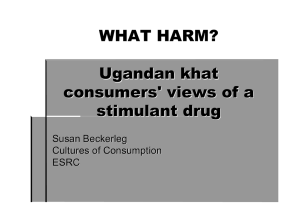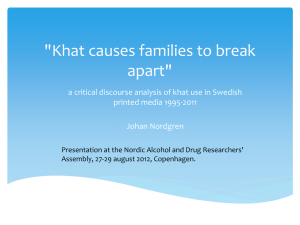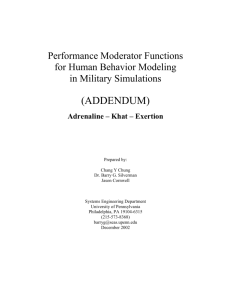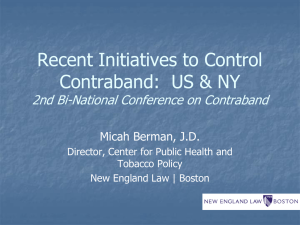to the presentation - UK National Smoking Cessation
advertisement
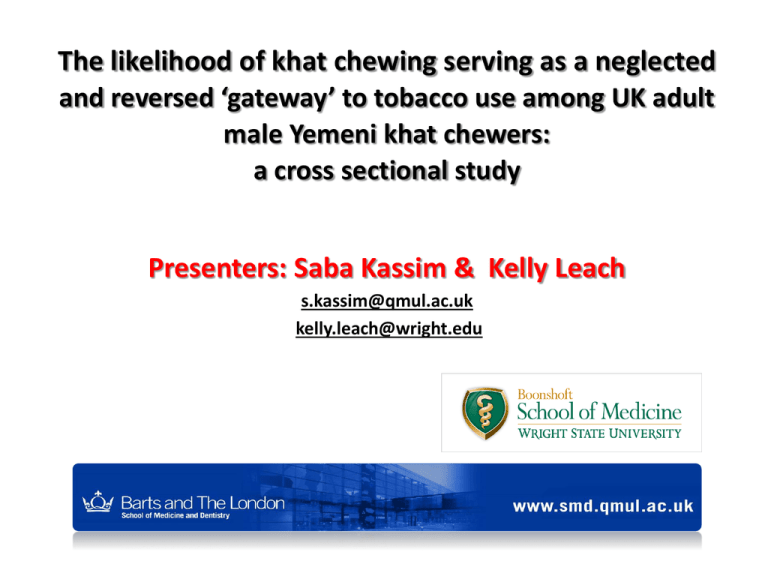
The likelihood of khat chewing serving as a neglected and reversed ‘gateway’ to tobacco use among UK adult male Yemeni khat chewers: a cross sectional study Presenters: Saba Kassim & Kelly Leach s.kassim@qmul.ac.uk kelly.leach@wright.edu Khat A green leaf with ‘amphetamine-like’ effects1 Chewed mainly for social interaction by Yemenis, Ethiopian and Somalis in homeland and diasporas2 Types: Yemeni, Ethiopian, Kenyan and other different brands with different levels of cathinone, Cathedulins and other unexplored components3,4 Illegal in many countries5 and the UK is more likely to enforce its illegalization6 on 24/6/2014 Khat Chewing Social & Health Impacts Social: Family budget constraints7 Health: khat dependence and Cardiovascular impacts8,9 Chewers: Either daily tobacco users e.g cigarette or; Use tobacco only when chewing khat10 Simultaneous tobacco and khat users (STKU) Rationale The WHO recommended that social influences of tobacco use should be tackled and addressed11 In the UK the National Institute for Health Care & Excellence (NICE) guidelines recommended that services should be tailored for community needs12 Aims • To assess aspects of tobacco use among STKU • To explore factors associated with tobacco use patterns (frequency of use per week) among STKU Methods 204 Yemeni male khat chewers were recruited via random visits to UK khat sale outlets13 Data collected via face-to-face interviews Items measured socio-demographics, khat chewing behaviours13 and dependence (SDS-khat14 and DSMIV8 tools) Tobacco use13 validated with carbon monoxide (CO) levels Results (1) Tobacco use status of 204 khat chewers 20% STKU 45% Daily cigarette smokers Results (2) The STKU mean age was 38.12±14.05 years and 55% were unemployed Table 1: Aspect of tobacco and khat use among STKU Categorical Variable Methods of tobacco use status Smoked cigarette Smoked waterpipe Smoked both cigarette and waterpipe Pattern of tobacco use 1-2days/week STKU ≥3 days/week STKU Initiator of tobacco smoking Khat chewing Former daily tobacco users Yes Continuous variable Number of cigarette smoked when chewed khat SDS-khat scores DSM-IV scores CO levels (PPM)b N (%) 25 (60) 14 (33) 3 (7) 24 (57) 18 (43) 19 (45) 31 (74) Mean(SD)a 15.07 (10.33) 5.36 (4.38) 1.42 (1.87) 16.00 (15.66) Number of attempts to quit smoking when chewing 2.77 (1.94) Number of attempts to quit chewing khat 3.13 (2.07) *M (SD) : mean and standard deviation; b=parts per million Results (3) Table 2*: Factors associated with pattern of tobacco smoking among STKU Variable SDS-khat scores DSM-IV scores cAmount of khat chewed during typical khat session Cigarettes smoked when chewing 1-2days/week STKU 24 3.25 ( 3.67) 2.00 ≥3days/week STKU 18 8.17 ( 3.68) 8.00 1-2days/week STKU 24 0.83 (1.37) 0.00 ≥3days/week STKU 18 2.22 (2.18) 2.00 1-2days/week STKU 24 1.44 (0.90) 1.00 ≥3days/week STKU 18 2.39 (1.01) 2.50 1-2days/week STKU 15 13.00 (5.59) 14.00 ≥3days/week STKU 13 17.46 (13.85) 10.00 1-2days/week STKU 24 6.30 (1.66) 6.00 ≥3days/week STKU 18 5.78 ( 2.29) 6.00 1-2days/week STKU 24 20.00 (5.87) 20.00 ≥3days/week STKU 18 18.06 (4.86) 19.00 c Age starting chewing khat bMdn N C Khat chewing session hours last aM Groups (SD) *Mann Whitney U Test results; aM (SD) = mean (standard deviation); bMdn= median; c Time frame last 12 months pEffect value size 0.001 0.53 0.015 0.35 0.002 0.48 0.856 0.032 0.270 0.17 0.282 0.17 Results (4) Table 3*: Factors associated with tobacco smoking among STKU Variable 1-2days/week STKU N=24 N (%) ≥3days/week STKU N=18 OR ( 95%CI) N (%) p-value aChewing more khat during first 2 hours of khat session Yes 3 (12.5) 8 (44.4) 5.60 (1.22, 25.75) 0.033 3 (12.5) 10 (55.6) 8.75 (1.90,40.24) 0.006 10 (41.7) 13 (72.2) 3.64 (1.00, 13.52) 0.049 11 (45.8) 8 (44.4) 0.95 (0.28,3.23) 0.929 Difficult 2 (7.3) 10 (55.6) 13.75 (2.46,76.82) 0.001 Health conditions Yes 4 (16.7) 8 (44.4) 4.00 ( 1.00,16.55) 0.049 aChewing even when ill Yes aWant to quit chewing Yes aAttempted to quit chewing Yes aWhole week not chewing *Chi square and Fisher exact tests; aTime frame last 12 months Discussion (1) The likelihood of khat chewing serving as neglected and reversed ‘gateway drug’ is possible: 45% initiated tobacco with khat as in other studies15. In this sample among daily cigarette smoker chewers tobacco use by 65% initiated within and after age of khat chewing initiation. Seventy four percent (74%) self-reported that khat chewing triggered tobacco use relapse. We hypothesise tobacco use among khat chewers follows a cyclical pattern. The social dimensions of khat and associated tobacco use16 and the role of tobacco use to enhance khat effects10 should be considered when explaining the failure of attempts to quit tobacco use when chewing. Discussion (2) The association of frequent tobacco and khat chewing with increased amount of khat chewed at the beginning of chewing session could be explained by the overlap of withdrawal symptoms of khat and tobacco. The increase in amount of khat chewed among frequent STKU might indicate drug use tolerance17. STKU delay tobacco intake until starting khat chewing, unlike daily tobacco smokers who smoke their first cigarette within hours of waking18. This could be a result of classical conditioning19. The interrelationship between khat chewing and tobacco use is still under-researched Conclusions Khat chewing may promote different patterns and methods of tobacco smoking, initiate and sustain tobacco smoking, and trigger tobacco cessation relapses among STKU. Increased frequency of tobacco smoking among STKU was linked to psycho-physical and behavioural factors, such as dependence on khat and more khat chewed during one session. Khat chewing should be considered when designing tobacco prevention uptake, cessation interventions and relapse prevention programmes for Yemenis and East African populations in the diaspora and homeland. References 1. 2. 3. 4. 5. 6. 7. 8. 9. 10. 11. 12. 13. 14. 15. 16. 17. 18. 19. Kalix, P., 1992. Cathinone, a natural amphetamine. Pharmacol Toxicol 70, 77-86. Kassim., Croucher, R., 2006. Khat chewing amongst UK resident male Yemeni adults: an exploratory study. Int Dent J 56, 97-101. Krizevski, R., Dudai, N., Bar, E., Lewinsohn, E., 2007. Developmental patterns of phenylpropylamino alkaloids accumulation in khat (Catha edulis, Forsk.). J Ethnopharmacol 114, 432-438. Kite, G.C., Ismail, M., Simmonds, M.S., Houghton, P.J., 2003. Use of doubly protonated molecules in the analysis of cathedulins in crude extracts of khat (Catha edulis) by liquid chromatography/serial mass spectrometry. Rapid Commun Mass Spectrom 17, 1553-1564. WHO, 2006. WHO Expert Committee on Drug Dependence. World Health Organ Tech Rep Ser, i, 1-21, 23-24 passim. The Misuse of Drugs Act 1971 (Amendment) Order 2014. http://www.legislation.gov.uk/uksi/2014/1352/made. Aden, A., Dimba, E.A., Ndolo, U.M., Chindia, M.L., 2006. Socio-economic effects of khat chewing in north eastern Kenya. East Afr Med J 83, 69-73. Kassim, S., Croucher, R., al'Absi, M., 2013. Khat dependence syndrome: a cross sectional preliminary evaluation amongst UK-resident Yemeni khat chewers. J Ethnopharmacol 146, 835-841. Ali, W.M., Al Habib, K.F., Al-Motarreb, A., Singh, R., Hersi, A., Al Faleh, H., Asaad, N., Al Saif, S., Almahmeed, W., Sulaiman, K., Amin, H., Al-Lawati, J., Al Bustani, N., Al-Sagheer, N.Q., Al-Qahtani, A., Al Suwaidi, J., 2011. Acute coronary syndrome and khat herbal amphetamine use: an observational report. Circulation 124, 2681-2689. Kassim, S., Islam, S., Croucher, R.E., 2011. Correlates of nicotine dependence in U.K. resident Yemeni khat chewers: a cross-sectional study. Nicotine Tob Res 13, 1240-1249. WHO, 2007. Gender and Tobacco control: A policty brief.http://www.who.int/tobacco/resources/publications/general/policy_brief.pdf. NICE, 2012. Smokeless tobacco cessation: South Asian communities -National Institute for Health and Care Excellence. www.nice.org.uk/nicemedia/live/13907/60914/60914.pdf. . Kassim S: An exploration of the association between khat chewing and health outcomes in UK-resident male Yemeni khat chewers. ; 2010:249–264. https://qmro.qmul.ac.uk/jspui/handle/123456789/494. Kassim, S., Islam, S., Croucher, R., 2010. Validity and reliability of a Severity of Dependence Scale for khat (SDS-khat). J Ethnopharmacol 132, 570-577. Belew M, Kebede D, Kassaye M, Enquoselassie F: The magnitude of khat use and its association with health, nutrition and socioeconomic status. Ethiop Med J 2000, 38(1):11–26. Kennedy J: The flower of paradise : the institutionalized use of the drug qat in North Yemen. Dordrecht. Lancaster: Reidel; 1987. Edwards G, Arif A, Hadgson R: Nomenclature and classification of drug and alcohol-related problems: a WHO memorandum. Bull World Health Organ 1981, 59(2):225–242. Heatherton TF, Kozlowski LT, Frecker RC, Fagerstrom KO: The Fagerstrom Test for Nicotine Dependence: a revision of the Fagerstrom Tolerance Questionnaire. Br J Addict 1991, 86(9):1119–1127. Leach KR, Rogers N: Mapping the effects of khat (catha edulis) and tobacco on the human brain: a biological illustration supporting the common pattern of dual substance use among khat chewers. Oral presentation. Germany: First European Khat Research Program Conference, Goethe Universitat, Frankfurt am Main; 2013. Acessed 29 March 2014 at http://khatresearch.org/EKRP/EKRPC2013.pdf.

